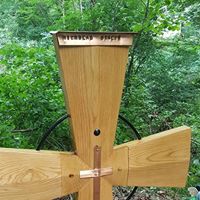James S Christy
age ~76
from Hayden, ID
- Also known as:
-
- James Steven Christy
- Phone and address:
- 12301 N Strahorn Rd, Hayden, ID 83835
James Christy Phones & Addresses
- 12301 N Strahorn Rd, Hayden, ID 83835
- 6415 Evernade Rd, Hayden, ID 83835 • (208)7625299
- 5735 English Point Rd, Hayden, ID 83835
- Hayden Lake, ID
- Spokane Valley, WA
- Spokane, WA
- 6415 E Evernade Rd, Hayden, ID 83835
License Records
James Christy
License #:
2705058407
Category:
Contractor
James Christy/Katri Christy
License #:
2705099694
Category:
Contractor
Lawyers & Attorneys

James Christy - Lawyer
view sourceISLN:
908389399
Admitted:
1970
University:
University of Illinois, B.A., 1967
Law School:
Loyola University, J.D., 1970

James Christy - Lawyer
view sourceISLN:
908389382
Admitted:
1973
University:
University of Cincinnati, B.B.A., 1969
Law School:
University of Cincinnati, J.D., 1972
Name / Title
Company / Classification
Phones & Addresses
Vice-President
Aerostar Aircraft Corporation
Law Enforcement · Mfg Aircraft
Law Enforcement · Mfg Aircraft
10555 N Airport Rd, Hayden Lake, ID 83835
(208)7620338
(208)7620338
Vice-President
American Aviation Inc
Marketing Firm
Marketing Firm
10555 N Airport Rd, Hayden, ID 83835
2265 W Aerostar Way, Hayden, ID 83835
(208)7628815
2265 W Aerostar Way, Hayden, ID 83835
(208)7628815
Manager
Xtreme Property Management LLC
IBASH PROPERTIES LLC
ROLSTON GREY LLC
T. C. TRUCKING-01 LLC
JPC LC
EDWARD STARR ENTERPRISES LLC
Us Patents
-
Aircraft Air Conditioning System
view source -
US Patent:43996655, Aug 23, 1983
-
Filed:Dec 7, 1981
-
Appl. No.:6/327813
-
Inventors:Hugh G. Evans - Spokane WA
Stephen Speer - Spokane WA
James S. Christy - Spokane WA
Stanley S. Lafrenz - Sandpoint ID -
International Classification:B60M 304
-
US Classification:62239
-
Abstract:An air conditioning system for powered aircraft is provided wherein a refrigerant compressor is located immediately adjacent to the alternator at the right forward portion of a horizontally opposed aircraft engine. The compressor is mechanically driven indirectly from the main bulkhead/starter ring gear assembly through a twin sheaved pulley on the alternator. The air conditioning system also is provided with two sets of inlet ports for cooling air flow to a refrigerant condenser. One set of inlet ports accepts ram air when the aircraft is airborne. The second set of ports is closable and accepts air when an interior intake impeller is activated. The engine-compressor-alternator combination fits within an aerodynamic cowling having no greater frontal area than one required for the engine without the compressor.
-
Vibration-Insulating Stability Improving Torque Force Device
view source -
US Patent:44285507, Jan 31, 1984
-
Filed:Oct 21, 1981
-
Appl. No.:6/313470
-
Inventors:Hugh G. Evans - Spokane WA
Stephen Speer - Spokane WA
James S. Christy - Spokane WA -
International Classification:B64C 1704
-
US Classification:244 93
-
Abstract:A conventional aircraft having horizontal stabilizers and hinged elevators, which is controlled, preferably, through push-pull rods, is provided with a dynamic torque (bob) weight connected to a rotating member, in the direct line of control to the elevator surfaces. The torque member is located in the nose portion of the aircraft with its center of gravity angled up from 20. degree. to 50. degree. when the elevator surfaces are in the neutral position. The torque member is also mounted in a flexible manner to isolate it from horizontal tail vibrations, or flutter.
-
Aircraft Engine-Turbocharger Package With Bleed Valve Control
view source -
US Patent:44690789, Sep 4, 1984
-
Filed:Jul 10, 1981
-
Appl. No.:6/281944
-
Inventors:Stephen R. Speer - Spokane WA
Hugh G. Evans - Spokane WA
James S. Christy - Spokane WA -
International Classification:F02B 3712
-
US Classification:123564
-
Abstract:In combination with an internal combustion engine and an air compressor, for use in an aircraft, the compressor providing compressed air to the engine's air inlet, there is provided a variable overboard bleed valve. The bleed valve is operated by a valve controller which controls the position of the bleed valve in response to changes in engine operating conditions. This permits maintaining optimum compressor operation over a wide range of engine operating conditions without exceeding the critical pressure of the compressor, so as to avoid surge. The controller can be preferably linked to the propeller governor and the throttle control for the aircraft, so as to move in response to combined movement of the governor and throttle control. The combined movement can be obtained using a pair of cables connected to a pivoting plate connected to the rotating control shaft of a butterfly valve.
-
Turbocharged Engine Having An Engine Speed And Throttle Position Responsive Compressor Bleed Valve
view source -
US Patent:44831471, Nov 20, 1984
-
Filed:Apr 27, 1981
-
Appl. No.:6/257864
-
Inventors:Hugh G. Evans - Spokane WA
Stephen Speer - Spokane WA
James A. Christy - Spokane WA -
International Classification:F02B 3712
-
US Classification:60611
-
Abstract:In combination with an internal combustion engine and an air compressor, for use in an aircraft, the compressor providing compressed air to the engine's air inlet, there is provided a variable overboard bleed valve. The bleed valve is operated by a valve controller which controls the position of the bleed valve in response to changes in engine operating conditions. This permits maintaining optimum compressor operation over a wide range of engine operating conditions without exceeding the critical pressure of the compressor, so as to avoid surge. The controller can be preferably linked to the propeller governor and the throttle control for the aircraft, so as to move in response to movement of the governor and throttle control.
Resumes

James Christy
view sourceLocation:
United States

James Christy
view sourceLocation:
United States
Isbn (Books And Publications)

Wikipedia References

James W. Christy
Plaxo

Christy James
view sourceFacilitator / Community Development Consultant at...

James Christy
view sourcePhoenix, AZJIM CHRISTY STUDIO
Myspace
Classmates

James Christy
view sourceSchools:
St. Joseph's Prep School Philadelphia PA 1955-1959, Cecilian Academy Philadelphia PA 1955-1959
Community:
Bridget Gallagher, Kenneth Laplaunt, Regina Giovinazzo

James Christy Jr (Christy)
view sourceSchools:
Fillmore High School Fillmore IN 1956-1960
Community:
James Oursler, Steve Robinson

James Christy
view sourceSchools:
Allen Park High School Allen Park MI 1988-1992
Community:
Renee Cook

James Christy
view sourceSchools:
Wooster High School Reno NV 1973-1977
Community:
Linda Cheel, Yvette Lopez

James Christy
view sourceSchools:
Saint John the Baptist School Monaca PA 1969-1976
Community:
Joseph D'alessandris, James Lowery

James Christy
view sourceSchools:
Hempfield Elementary School Greenville PA 1981-1984, East Elementary School Greenville PA 1985-1987, Mercer County Vocational Technical School Mercer PA 1991-1994
Community:
Steve Smith, Richard Sweigard, William Sweigard, Tom Hodge

James Christy
view sourceSchools:
Lockney Junior High School Lockney TX 1978-1978
Community:
Darlene Lambert, Fran Lapp

James Christy
view sourceSchools:
Plainville High School Mariemont OH 1941-1945
Community:
Nancy Ross, Barbara Mueller
Youtube
News

NASA releases Pictures Showing a day on Pluto and Its Moon Charon
view source- Charon was discovered by United States Naval Observatory astronomer James Christy, using the 1.55-meter telescope at NOFS, and was formally announced to the world via the International Astronomical Union on July 7, 1978. Subsequent observations of Pluto determined that the bulge was due to a smaller
- Date: Nov 21, 2015
- Category: Sci/Tech
- Source: Google

US Spacecraft Sails by Pluto, Capping 9-year Journey
view source- Other celestial-minded VIPs included James Christy, discoverer of Pluto's big moon Charon, and Sylvia Kuiper des Tombe, daughter of Dutch-American Gerard Kuiper for whom the mysterious zone surrounding Pluto is named. Some Pluto Children born Jan. 19, 2006, the very day New Horizons departed Earth
- Date: Jul 15, 2015
- Source: Google

How our view of Pluto and its moons has transformed through the decades
view source- scientists used data collected by the Hubble Space Telescope and other observatories to learn more about Pluto and hunt for moons around the tiny planet. The small planet's largest moon Charon was discovered in 1978 by U.S. Naval Observatory astronomer James Christy peering through a telescope in Arizona.
- Date: Jul 09, 2015
- Category: Sci/Tech
- Source: Google

Climate Quitters: Sorry You Lose
view source- Spencer, it is fair to say, does not have a sparkling reputation among climate scientists, not least because he and UAH colleague James Christy previously maintained that their data showed no warming in Earth's atmosphere, a claim long embraced by deniers but one that Spencer and Christy now concede
- Date: Sep 15, 2011
- Source: Google
Flickr
Googleplus

James Christy
Work:
Pokémon - Manager
Education:
University of Notre Dame

James Christy
Education:
Lol
Tagline:
James is just this guy, you know?

James Christy
Relationship:
Single
About:
BE COOL AND SEXY DUDE
Tagline:
COOL
Bragging Rights:
RUNNING ACROSS SUCCESS

James Christy

James Christy

James Christy

James Christy

James Christy

James Christy
view source
James True Christy
view source
James Christy
view source
James Christy
view source
James Christy
view source
James Christy
view source
James Christy
view source
James J. Christy
view sourceGet Report for James S Christy from Hayden, ID, age ~76













